人教版英语七下Unit2单元教材分析
人教版新目标七年级英语下册 Unit 2教学设计

人教版新目标七年级英语下册 Unit 2教学设计一. 教材分析人教版新目标七年级英语下册Unit 2主要围绕日常生活话题,让学生学会描述日常活动、表达喜好和计划。
本单元包括三个部分:听说课、读课和综合语言运用课。
听说课主要训练学生的听说能力,读课通过阅读提高学生的理解能力,综合语言运用课则培养学生的综合语言运用能力。
二. 学情分析七年级的学生已经掌握了基本的英语语音、词汇和语法知识,具备一定的听说读写能力。
但部分学生对英语学习仍存在恐惧心理,缺乏自信心。
因此,在教学过程中,教师需要关注学生的情感态度,激发他们的学习兴趣,提高课堂参与度。
三. 教学目标1.知识目标:学生能够掌握日常生活中常用的词汇和表达方式,如goto school, read books, watch TV等。
2.能力目标:学生能够在真实情境中运用所学知识进行日常交流,提高听、说、读、写的能力。
3.情感目标:学生能够积极参与课堂活动,提高学习英语的自信心和兴趣。
四. 教学重难点1.重点:学生能够熟练运用日常词汇和句型描述日常生活。
2.难点:学生能够正确使用一般现在时表达习惯性动作和喜欢的事物。
五. 教学方法1.任务型教学法:通过完成各种实际任务,让学生在实践中学习、运用英语。
2.情境教学法:创设真实的语境,激发学生的学习兴趣和积极性。
3.情感教学法:关注学生的情感需求,营造轻松、愉快的学习氛围。
六. 教学准备1.教师准备:提前备课,熟悉教材内容和教学目标。
2.学生准备:预习新课内容,复习相关知识点。
3.教学资源:准备多媒体教学课件、图片、实物等。
七. 教学过程1.导入(5分钟)利用图片或实物展示日常生活中的人物和活动,引导学生谈论他们的日常喜好。
例如,展示一张学校操场上的图片,让学生描述图片中学生在做什么。
2.呈现(10分钟)教师通过PPT展示本节课的主要词汇和句型,如go to school, read books, watch TV等,并用例句展示如何运用这些词汇和句型。
高中英语_book7unit2 robots reading教学设计学情分析教材分析课后反思

教学设计Teaching goals 教学目标1. Target language目标语言a. 重点词汇和短语fiction, cartoon, desire, satisfaction, absent, alarm, alarmed, smooth, embarrass, sympathy, elegant, pile, scan, fingernail, absurd, haircut, accompany, curtain, cushion, carpet, paint, awful,affair, firm, firmly, declare, victory, envy, marriage, test out, ring up, turn around, leave aloneb. 重点句型1. She felt embarrassed and quickly told him to go.2. Claire thought it was ridiculous to be offered sympathy by a robot.3. By the amused and surprised look on her face, Claire knew that Gladys thought she was having an affair.2. Ability goals能力目标: Help students to learn about robots and science fiction.3. Learning ability goals学能目标:Enable students to realize science fiction reflects scientific thought; a fiction of things-to-come based on things-on-hand.Teaching important points教学重点Teach students to enjoy science fiction. Enable students to grasp what Tony did to help Claire and how her emotion developed during Tony’s stay at her house. Help students to sum up characteristics of science fiction.Teaching difficult points 教学难点How Claire’s emotion developed during Tony’s stay at her house.Teaching methods教学方法Discussing, explaining, reading and practisingTeaching aids教具准备The multimedia computerTeaching procedures & ways教学过程与方式Step I Warming upDeal with Warming up. Present photos of different kinds of robots. Then ask them tosay something about his or her favorite robot.T: Good morning /afternoon, class!Ss: Good morning/ afternoon, Mr. /Ms…T: In this class we are going to learn about robots. Who would like to tell me what a robot is?S1:A robot is a machine.T: What kind of machine?S2: A robot is a kind of machine that can do a variety of often complex human tasks. T: How can a robot perform human tasks?S3: A robot is controlled by a computer.T: You are right. Then we can give the definition of a robot like this:A robot is a machine designed to do jobs that are usually performed by humans. Robots are programmed and controlled by a computer.(Today there are different kinds of robot, including industrial robots, household robots, and entertainment robots. Robots also often appear as characters in stories.)In groups, make a list of any science fiction, literature, films, video games, TV shows and cartoons you know that include robots as characters. Choose one and be prepared to tell the class about it briefly.Step II Pre-readingAsk students to discuss the questions in pre-reading in groups. Students are encouraged to speak out their opinion freely, no matter what it is. Teacher should encourage students to use their imagination.Step III ReadingDeal with the reading part.ScanningAsk the students to scan the text and find out what Tony looks like.T: Ok. I’m glad you had a heated discussion. Now I’d like you to meet Tony-- a robot that looks exactly like a human being. He is a character in the science fiction Satisfaction Guaranteed by Isaac Asimov. Please read the text and find the answers to the following questions.Show the following questions on the PowerPoint.1. What did Tony look like?2. What did Tony do to make Claire and her home elegant?Several minutes later check the answers with the whole class.Suggested answer:1. He was tall and handsome although his facial expressions never changed. His hair was smooth and black and his voice was deep.2. Tony gave Claire a new haircut and changed the makeup she wore. He also suggested Claire buy new curtains, cushions, a carpet and paint for the house and new dresses for herself. He made improvements on the house so that the house looked very elegant.Careful Reading1. Claire's feelings toward Tony changed as the story developed. Read the story, then fill in the occasions when Claire had these feelings.Comprehending questions on Page 12 Ask students to read the text carefully and then discuss the comprehending questions on Page 12 in groups.T: Now let’s read the text carefully and then do the comprehending exercises on Page 12.Several minutes later check the answers with the whole class.Suggested answers:2.1. He wanted Claire’s guests to see him and Claire together so that she would be envied by the women guests.2.2 He had prevented Claire from harming herself by making her feel good aboutherself. He helped her make her and her home elegant so that she would not feel like a failure.2.3 Because the company (designers) felt that they could not have women falling in love with a robot.2.4 Various answers can be accepted.2.5 When she first saw the robot, she felt alarmed. Tony didn’t look like a machine at Before hearrived When he offered tohelp her dress When he offered to help her improve her house and herselfHelped her with the sales manWhen she fell off aladder and caught byTony When she heard Gl adys whispering toanother woman thatShe rememberedTony was just amachineall. She felt embarrassed when Tony asked her whether she needed help dressing.Claire thought it was ridiculous to be offered sympathy by a robot.She was amazed by the fingernails and the softness and warmth of his skin.She screamed, pushed him away and ran to her room for the rest of the day.What a sweet victory to be envied by those women. She might not as beautiful as them, but none of them had such a handsome lover. Then she remembered—Tony was just a machine. She cried all night.3.Claire’s emotion developmentAfter dealing with the comprehending exercises, ask students to work together to find how Claire’s emotion developed.Suggested answer:At first refused to have Tony at her house---accept him----trust him---- proud ofhim----love him---sad to remember he was just a machineT: From her emotion development, we can see Tony was designed as a Mr. Perfect. He is designed not to harm Claire or allow her to be harmed. This is one of Isaac’s three laws for robots. Later in this unit we will learn more about his three laws.Characteristics of science fictionT: As you know, the story was written in 1951. With the development of science, some of the functions performed by Tony have come true. From this story we can draw a conclusion:Science fiction is often based on scientific principles and technology.Science fiction may make predictions about life in the future.Please remember these are some characteristics of science fiction. If you are interested, you may write short science fictions in your spare time.ExplanationDuring this procedure Teacher will play the tape recording for students. Students will underline the difficult sentences. After listening to the tape, Teacher will explain the text and deal with language problems.T: Now we will deal with some difficult language focuses. Now I will play the recording of the text for you. Please make a mark where you have difficulties.After listening to the recording, explain the difficult sentences to students. Before explaining the difficult points, students are asked to refer to the notes to the text on Page88-89.T: Do you have any difficulties with the text?S1:Could you please explain the sentence to us:She felt embarrassed and quickly told him to go. T: Because Tony didn’t look like a machine at all, when Tony offered to help her get dressed, she was embarrassed, perhaps shy to get a “man” help her dressing.S2: How to understand this sentence: Claire thought it was ridiculous to be offered sympathy by a robot.T: In spite of the fact that Tony looked so human, he was just a machine. So Claire thought it was foolish that Tony offered her sympathy. Do you have any other questions?Ss: No.T: Maybe someday we will have robots that have feelings and can also think for themselves. Please remember science fiction reflects scientific thought;things-to-come based on things-on-hand. Ok, that’s all for today. Don’t forget to surf the internet to learn more about the great writer and his stories. Of course you will learn more about robots.Step IV Homework:.Surf the internet to learn more about robots and science fiction.Book7 Unit2 RobotsZhang Jinchao 2016.5I. Warming-up:1. What is a robot?A robot is a machine __________ to do jobs that are usually _________ by humans . Robots are ___________ and ___________ by a computer.2. What can robots do ?_____________________________________________________________ ___________________________________________________________ 3.Today there are different kinds of robot, including industrial robots, household robots, and entertainment robots.II. Fast reading1. What is the text mainly about ?It’s mainly about how a household ______ was ______ _____ in a family.2. Characters in the story(1).__________________----employed in a company that makes robots(2). ___________________ -----Larry’s wife, a housewife(3). _____________________----- the robot(4)._______________________------a woman that Claire envies3.Choose the best answer:(1)Why did Claire feel alarmed at the sight of Tony? ______A. Because he was a robot.B. Because she didn't like him.C. Because he was more like a being than a machine.D. Because he never changed his facial expressions.(2) The robot Tony helped Claire to realize her dreams by ______.A. making her home elegantB. giving her a new haircut and changing the make-up she woreC. giving her advice on her dressesD. all the above(3) As a result, the experiment shows _______.A. Claire and Tony fell in love with each otherB. Tony had to be rebuiltC. Tony was angry with his designerD. Both A and B(4) All the following statements are true except _______.A. Tony tried to please ClaireB. Claire tried to displease TonyC. Tony managed to protect ClaireD. Gladys admired Claire for Tony(5) We can infer from the passage that_____.A.Claire liked Tony but feared himB.Claire cried because Tony made her angryC.Claire forgot Tony as soon as Tony leftD.Tony had no feelings as human being4.True or false.(1)Larry was going to be away from home so he hired a robot to accompany his wife.( )(2)Claire didn’t like the idea at the beginning, but she agreed to it at last.( )(3) Tony could understand Claire when she said she was not clever.( )(4)It was Claire that first decided to invite Gladys and her friends to her house.()(5)Claire’s guests were filled with admiration when they saw her house was completely changed.( )(6)The company was satisfied with Tony’s report because he had successfully made a woman fall in love with him..( )III. Careful reading1.Fill in the blanks.2. Find out the Claire’s Feelings to Tony with the occasion.(1)Before he arrived ( )(2) When he arrived ( )(3) When he offered to help her dress ( )(4) When he offered to help her improve her ( )(5) When he helped her with the salesman ( )(6)When she fell off a ladder and was caught ( )(7)When she heard Gladys whispering to another ( )(8) She remembered Tony was just a machine ( )A .cried all night B. admired him C. felt embarrassedD. felt his warmthE. felt being enviedF. called himG. dislike him womanH. was alarmedFind out the right order about how Claire’s emotion developed.D→_________ →_______→_________→_________→________A. Sad to remember he was just a machineB. accepted himC. proud of himD. refused to have Tony at her houseE. trusted himF. loved himIV. Post readingRead the story again and answer the following questions in group.1. Why did Tony open the curtains?2. Why did Tony have to be rebuilt?3. What’s the original function of the robot, Tony? Did Tony guarantee the satisfaction to Claire?V .SummaryA robot was going to _____________(test out) by Larry’s wife. When she first saw the robot, she felt ____________(alarm)because he seemed more like a human than a machine. He was tall and handsome __________ smooth hair and deep voice although his ________________(face)expression never changed. On the second morning when the machine asked her whether she needed help dressing, the lady felt _______________(embarrass)and drove him out of her room. Later, as a _____________(favorable),Tony helped Claire feel good about herself and made her home more ___________(elegance).He gave her a new haircut and ______________(accompany) her to the shop. Claire began to trust him and thosepowerful women in her neighborhood_____________(envy) her very much. However , Tony has to ________________ (rebuilt)because we cannot have women __________________(fall in love)with machines.VI . Make up the story学情分析通过高中近两年的英语学习,大多数学生已能听懂有关熟悉话题的语段和简短的故事。
七年级英语Go_for_it!_Unit_2_说课稿课件人教版新目标
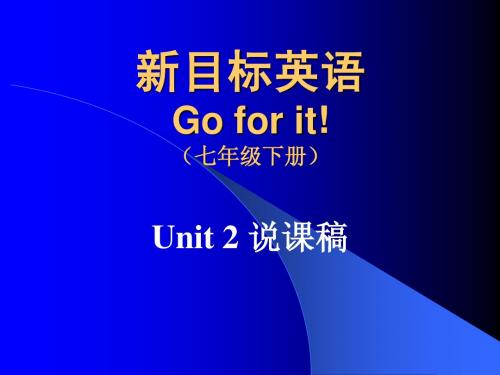
三、教学目标
1、语言知识 词汇: A、重点掌握表示建筑物种类的名词, 如post office, hotel, bank, supermarket, street, pay phone, avenue, B、掌握如下描绘性形容词及方位副词,如 clean, quiet, dirty, busy, right, left, down, along, C、方位介词,如next to, across from, in front of, near, between, behind D、短语,如 turn right, turn left, go down, go straight on, walk along, go along,
2、教材的地位及其作用 、 本单元的教学主要内容是:学习“问路指路”的 常用表达方式 ,该话题与学生的日常生活紧密 联系在一起,容易唤起学生的学习兴趣,这对 于提高学生的综合能力很有帮助,特别是说的 能力。通过本单元的学习描述某一建筑物的位 置,学会问路,指路,学会利用地图描述某一 社区。 本单元继续使用一般现在时,这是一个生活中离 不开的时态,也是最基本的一个时态。新课程 标准要求学生重点掌握一般现在时,这在英语 中使用频率很高,学好这一时态的用法对以后 其他时态的学习和交际有很大的帮助。
Students listen to teacher’s instruction and draw out the maps:
Map 1: Across from the bank is a supermarket. There is a post office between the library and the supermarket. Across from the supermarket is a park. Next to the park is a restaurant. Map 2: A library is next to the park. Across from the park is a bank. Next to the bank is a post office. Across from the post office is the restaurant, which is across from the supermarket.
教师备课——英语七年级下UNIT2教案2
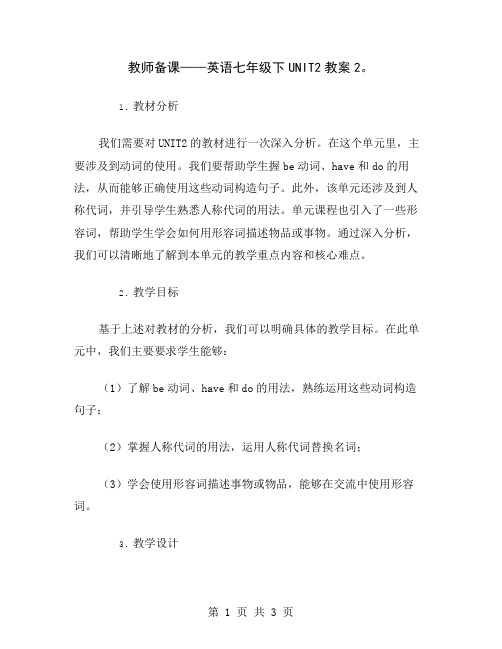
教师备课——英语七年级下UNIT2教案2。
1.教材分析我们需要对UNIT2的教材进行一次深入分析。
在这个单元里,主要涉及到动词的使用。
我们要帮助学生握be动词、have和do的用法,从而能够正确使用这些动词构造句子。
此外,该单元还涉及到人称代词,并引导学生熟悉人称代词的用法。
单元课程也引入了一些形容词,帮助学生学会如何用形容词描述物品或事物。
通过深入分析,我们可以清晰地了解到本单元的教学重点内容和核心难点。
2.教学目标基于上述对教材的分析,我们可以明确具体的教学目标。
在此单元中,我们主要要求学生能够:(1)了解be动词、have和do的用法,熟练运用这些动词构造句子;(2)掌握人称代词的用法,运用人称代词替换名词;(3)学会使用形容词描述事物或物品,能够在交流中使用形容词。
3.教学设计基于教材分析和教学目标,我们需要进行详细的教学设计。
我们可以通过提供一些生动的语言材料,向学生展示be动词、have和do 的用法。
在这个过程中,可以帮助学生发现一些常见的语言规律和用法,如肯定句、否定句和疑问句等。
同时,也可以通过练习帮助学生熟悉这些动词的使用方法。
我们可以引导学生熟悉人称代词的使用。
通过对语言材料的分析和练习,学生可以逐渐理解代词在句子中的作用和用法,并掌握有效地使用人称代词进行交际的技能。
我们可以引入形容词,让学生重点了解形容词与名词搭配方法,并且在生活实践中加强彼此搭配的印象。
在此过程中,教师要注意语言的生动性和趣味性,让学生更好地理解用法,同时,鼓励他们在交流中积极运用词汇。
4.教学评估在教学过程中,我们需要对学生的掌握情况进行评估。
在这个过程中,我们可以使用各种形式的评估方法,如听力、口语、阅读和写作等,以帮助学生全面地巩固并使用教材中的词汇和语法。
5.课后回顾最后要注意的是,教师在教学结束后,应该对教学过程进行总结和回顾,以保证学生可以更好地理解和掌握所学的内容。
在回顾过程中,可以和学生讨论一些重点难点,从而加深对其的印象,巩固所学的知识。
人教版七年级英语下册全套教案
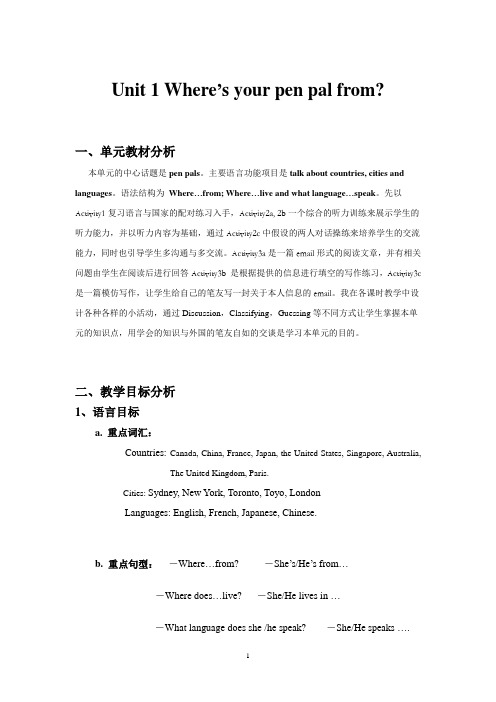
Unit 1 Where’s your pen pal from?一、单元教材分析本单元的中心话题是pen pals。
主要语言功能项目是talk about countries, cities and languages。
语法结构为Where…from; Where…live and what language…speak。
先以Activity1复习语言与国家的配对练习入手,Activity2a, 2b一个综合的听力训练来展示学生的听力能力,并以听力内容为基础,通过Activity2c中假设的两人对话操练来培养学生的交流能力,同时也引导学生多沟通与多交流。
Activity3a是一篇email形式的阅读文章,并有相关问题由学生在阅读后进行回答Activity3b 是根据提供的信息进行填空的写作练习,Activity3c 是一篇模仿写作,让学生给自己的笔友写一封关于本人信息的email。
我在各课时教学中设计各种各样的小活动,通过Discussion,Classifying,Guessing等不同方式让学生掌握本单元的知识点,用学会的知识与外国的笔友自如的交谈是学习本单元的目的。
二、教学目标分析1、语言目标a. 重点词汇:Countries: Canada, China, France, Japan, the United States, Singapore, Australia,The United Kingdom, Paris.Cities: Sydney, New York, Toronto, Toyo, LondonLanguages: English, French, Japanese, Chinese.b. 重点句型:-Where…from? -She’s/He’s from…-Where does…live? -She/He lives in …-What language does she /he speak? -She/He speaks ….2、能力目标a. 培养学生在文段中寻找信息的能力;b. 学会用英文给笔友写回信,简单介绍个人情况;c. 通过有效地小组合作,培养学生合作能力及团队精神。
初中英语七年级 Starter Unit 2 教案

Starter Unit 2What's this in English?一、单元教材分析本单元要求学生掌握英文字母Ii—Rr,能认读其印刷体和手写体字母的大小写等四种形式。
书写(大写和小写,笔顺,笔画)基本合乎要求。
注意总结元音字母a 、e、i和o的发音规则。
本单元围绕“认物”这一话题开展听、说、读、的学习活动,学习一些简单的事物的英文词汇,并能用所学的句型去熟悉周围的一些事物的名称。
让学生们学会在生活中如何确认事物。
通过辨认事物,学生们学习一些词汇,并巩固所学的句型。
二、单元学情分析本单元围绕“认物”这一话题开展听、说、读、写的学习活动。
通过所学的句型—What's this in English? —It's a…—What's that in English? —It's a…”去熟悉周围的一些事物的名称。
此外,通过学习让学生们明白this和that均指代单数的事物,this指代离说话者较近的事物,that指代离说话者较远的事物,it指代上文出现的事物,也可指代上文出现的this或that。
用英语确认周围常见事物比较适合初学者的实际情况,难度不大,易调动学生们的学习兴趣。
三、单元教学建议在本单元的教学中可采用的学习策略有:兴趣活动教学策略,多采用做游戏和猜谜等形式;任务型教学策略,在教学中应突出语言的应用性原则,把听说、讨论、表演、游戏贯穿于教学,使课堂形式多样化,充分发挥学生的主动性。
采用自主学习、小组合作学习、Role playing、pair work等方法开展听、说、读、写的学习活动。
四、单元课时分配本单元可用2课时完成教学任务:(1a-2e) 用1课时(3a-4d) 用1课时(1a-2d)一、教学目标:1. 语言知识目标:1) 能掌握以下词汇:字母Ii ~ Rr, what, is, what's, this, in, English, in English, that, map,cup, ruler, pen, orange, jacket, key, quilt, it, a(n)2) 能掌握以下句型:①—What's this in English? —It's an orange.②—What's that in English? —It's a map?3) 能运用所学的句型询问确认周围的事物,并学会事物的英语名称。
初中英语_英语七年级下册 Unit 2教学设计学情分析教材分析课后反思

《Unit 2 I ’ m going to study computer science.》SectionA教学设计Section A Review(复习学案)一、【学习目标】Learning aims(一)知识目标1)熟练运用Section A出现的单词和短语2)能正确默写出Section A中的重点句子(二)技能目标学习并使用be going to做题(三)情感目标1)通过小组合作学习培养合作互助的理念;2)通过谈论未来的职业,树立为理想奋斗的信念。
二、【学习重点】1)熟练运用Section A出现的单词、短语、句型谈论自己的理想工作;2)能顺利完成任务八,写出报告。
三、【导学过程】Step1 课前预习,自主学习,完成任务一:词型转换1. violin(n. )→(n. )小提琴手2. piano(n. )→(n. )钢琴家3. drive(v. )→(n. )司机4. science(n. )→(n. )科学家5. teach(v. )→(n. )教师6. cook(v. )→( n. )厨师7. act(v. )→( n. )演员8.engine (n. 机车) →( n. )机械师、工程师9. play(v. )→(n. )运动员10.write (v. )→( n. )作家.构词法表示……的人1.名词+ist→表示职业的名词。
violin → violinist piano → pianistscience → scientist art→ artist(艺术家)2.动词+er/or/ress→表示职业名词teach → teacher act → actor actressdrive → driver visit → visitor (参观者)play → player swim → swimmer (游泳的人)Step2 词汇达标,完成任务二一、根据句意及汉语提示写单词。
1.Tom's father and brother are both ________(厨师).2.Tell me where this ________(飞行员)comes from.3.The boy wants to be a(n) ________(司机).4.How many ________(医生) are there in this hospital?5.The two ____ ____(工程师) are discussing a plan of the city.二、用所给词的适当形式填空。
人教版英语七年级下册Unit 2 Section B 1a--1e教案设计
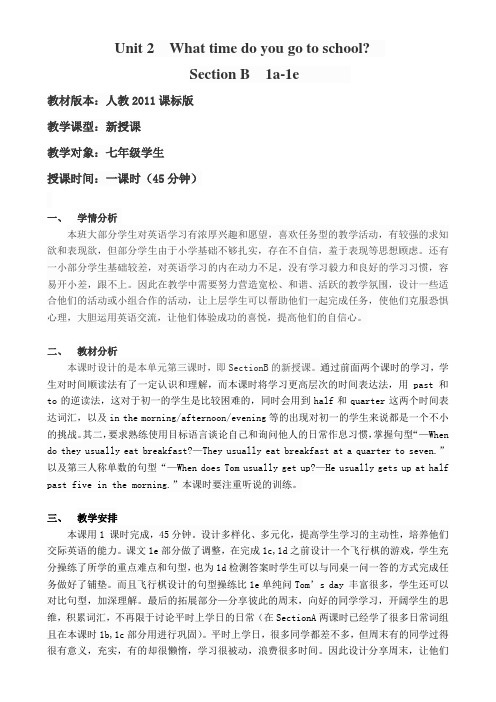
Unit 2 What time do you go to school?Section B 1a-1e教材版本:人教2011课标版教学课型:新授课教学对象:七年级学生授课时间:一课时(45分钟)一、学情分析本班大部分学生对英语学习有浓厚兴趣和愿望,喜欢任务型的教学活动,有较强的求知欲和表现欲,但部分学生由于小学基础不够扎实,存在不自信,羞于表现等思想顾虑。
还有一小部分学生基础较差,对英语学习的内在动力不足,没有学习毅力和良好的学习习惯,容易开小差,跟不上。
因此在教学中需要努力营造宽松、和谐、活跃的教学氛围,设计一些适合他们的活动或小组合作的活动,让上层学生可以帮助他们一起完成任务,使他们克服恐惧心理,大胆运用英语交流,让他们体验成功的喜悦,提高他们的自信心。
二、教材分析本课时设计的是本单元第三课时,即SectionB的新授课。
通过前面两个课时的学习,学生对时间顺读法有了一定认识和理解,而本课时将学习更高层次的时间表达法,用past和to的逆读法,这对于初一的学生是比较困难的,同时会用到half和quarter这两个时间表达词汇,以及in the morning/afternoon/evening等的出现对初一的学生来说都是一个不小的挑战。
其二,要求熟练使用目标语言谈论自己和询问他人的日常作息习惯,掌握句型“—When do they usually eat breakfast?—They usually eat breakfast at a quarter to seven.”以及第三人称单数的句型“—When does Tom usually get up?—He usually gets up at half past five in the morning.”本课时要注重听说的训练。
三、教学安排本课用1 课时完成,45分钟。
设计多样化、多元化,提高学生学习的主动性,培养他们交际英语的能力。
人教七年级下册英语unit2知识点总结
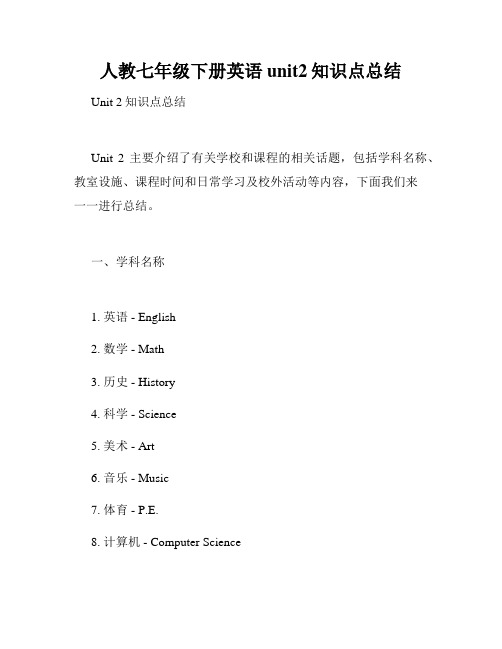
人教七年级下册英语unit2知识点总结Unit 2知识点总结Unit 2主要介绍了有关学校和课程的相关话题,包括学科名称、教室设施、课程时间和日常学习及校外活动等内容,下面我们来一一进行总结。
一、学科名称1. 英语 - English2. 数学 - Math3. 历史 - History4. 科学 - Science5. 美术 - Art6. 音乐 - Music7. 体育 - P.E.8. 计算机 - Computer Science二、教室设施1. 黑板 - blackboard2. 白板 - whiteboard3. 投影仪 - projector4. 音响 - sound system5. 地图 - map6. 水龙头 - tap7. 电视 - TV8. 电脑 - computer9. 灯 - light10. 窗户 - window三、课程时间1. 上午 - in the morning2. 下午 - in the afternoon3. 晚上 - in the evening4. 早上 - in the early morning5. 夜晚 - at night6. 每周 - every week7. 每天 - every day8. 周末 - on weekends四、日常学习1. 做作业 - do homework2. 练习 - practice3. 复习 - review4. 读书 - read books5. 写作 - write compositions6. 讨论 - have discussions7. 板书笔记 - take notes8. 教师讲解 - teacher's explanation9. 学习笔记 - study notes10. 做练习 - do exercises五、校外活动1. 课外活动 - extracurricular activities2. 运动会 - sports meeting3. 聚会 - party4. 社交活动 - social activities5. 英语角 - English corner6. 爱好小组 - hobby group7. 社团活动 - club activities8. 学校之旅 - school trip以上就是Unit 2的主要内容,希望能够帮助大家更好地学习英语,更好地了解学校和课程的相关话题。
人教版七年级英语下册教材分析

人教版七年级英语下册教材分析一、教材总体概述人教版七年级英语下册教材是依据《英语课程标准》编写的,旨在培养初中学生英语语言知识和语言技能,提高其实际运用英语的能力。
该教材内容丰富,包括各种话题和场景,注重培养学生的听、说、读、写技能,同时强调语言学习的实践性和应用性。
二、教学目标分析本册教材的教学目标是:1.知识目标:学生能够掌握本册教材所涉及的词汇、语法、句型等语言知识,了解英语国家的文化背景和习俗。
2.能力目标:学生能够运用所学知识进行听、说、读、写等技能训练,提高综合运用英语的能力;同时,培养学生的自主学习和合作学习能力。
3.情感目标:激发学生学习英语的兴趣和积极性,培养其自信心和跨文化意识,增强学生的国际视野和全球意识。
4.态度目标:培养学生积极的学习态度和价值观,使其能够在学习英语的过程中保持积极向上的心态。
5.文化目标:增强学生的跨文化意识,培养其对多元文化的尊重和包容态度。
三、教学内容分析本册教材包括10个单元,每个单元有以下几个部分:1.Unit Goals:介绍本单元的学习目标和要求。
2.Lessons:每个单元包含4个Lessons,每个Lesson包括课文、词汇、语法、练习等内容。
3.Word Bank:提供与本单元内容相关的词汇和短语。
4.Recycling Time:对本单元所学的语言知识进行复习和巩固。
5.Songs and Chants:提供与本单元主题相关的歌曲和歌谣,增加学习的趣味性和实用性。
6.Workbook:提供练习册,包括听说读写等方面的练习题。
四、教材结构分析本册教材的结构清晰,内容安排合理。
每个单元都有明确的学习目标和要求,以及相应的练习和活动,帮助学生巩固所学知识。
教材中穿插了大量的图片和插图,使内容更加生动有趣。
此外,教材还配备了录音和教师用书等辅助材料,方便教师和学生使用。
五、教学方法与技巧教师在使用本册教材时,可以采用以下教学方法与技巧:1.激活学生的前知:教师可以通过提问、讨论等方式了解学生对已学知识的掌握情况,为后续教学做好铺垫。
初中英语_Unit2教学设计学情分析教材分析课后反思
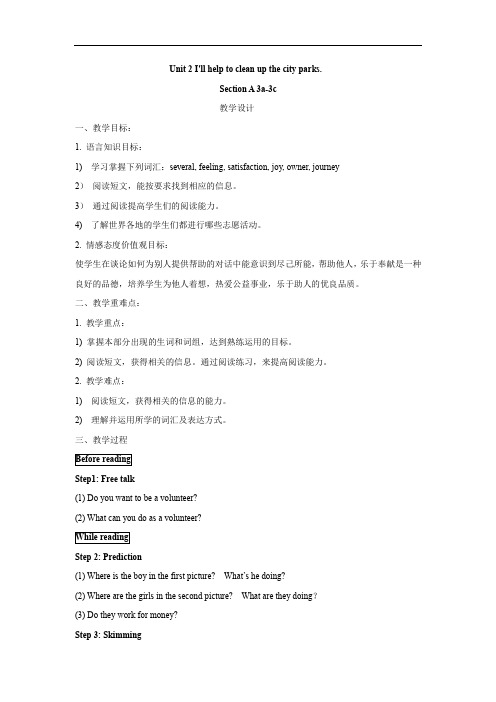
Unit 2 I'll help to clean up the city parks.Section A 3a-3c教学设计一、教学目标:1. 语言知识目标:1) 学习掌握下列词汇:several, feeling, satisfaction, joy, owner, journey2)阅读短文,能按要求找到相应的信息。
3)通过阅读提高学生们的阅读能力。
4) 了解世界各地的学生们都进行哪些志愿活动。
2. 情感态度价值观目标:使学生在谈论如何为别人提供帮助的对话中能意识到尽己所能,帮助他人,乐于奉献是一种良好的品德,培养学生为他人着想,热爱公益事业,乐于助人的优良品质。
二、教学重难点:1. 教学重点:1) 掌握本部分出现的生词和词组,达到熟练运用的目标。
2) 阅读短文,获得相关的信息。
通过阅读练习,来提高阅读能力。
2. 教学难点:1) 阅读短文,获得相关的信息的能力。
2) 理解并运用所学的词汇及表达方式。
三、教学过程Step1: Free talk(1) Do you want to be a volunteer?(2) What can you do as a volunteer?Step 2: Prediction(1) Where is the boy in the first picture? What’s he doing?(2) Where are the girls in the second picture? What are they doing?(3) Do they work for money?Step 3: SkimmingRead the passage quickly and fill in the blanks. Students Who Volunteer:Mario works in:…an animal hospitalLoves: animalsMary works in: an after-school reading programLoves: readingStep 4:ScanningTask1: Read Para.2 and answer.What does Mario volunteer to do?He volunteers at an animal hospital to care for animals. Task2: Read Para.2 and fill in the chart.Task3: Read Para.3 and answerWhat does Mary volunteer to do?She works at an after-school reading program to help kids to readTask4: Read Para.3 and fill in the chart.Task5: Looking & Thinking观察表格中蓝色字体的动词短语及相应的横线上所填的单词,可以看出,to后均用的动词的______形式,这种_________________即为动词不定式的基本形式。
Unit2Trditionalskills第二课时说课稿
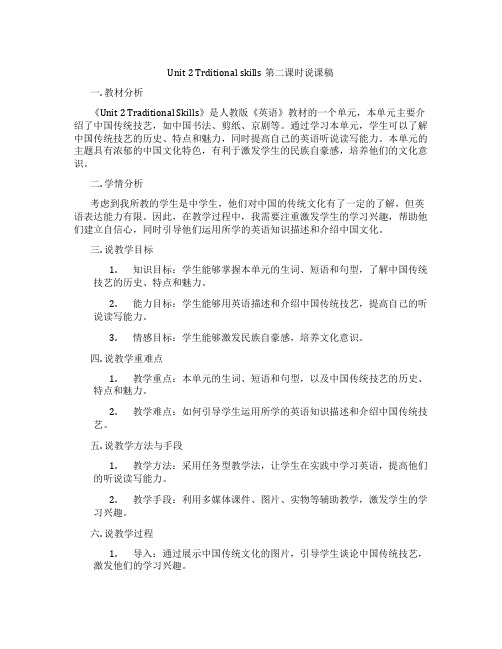
Unit 2 Trditional skills第二课时说课稿一. 教材分析《Unit 2 Traditional Skills》是人教版《英语》教材的一个单元,本单元主要介绍了中国传统技艺,如中国书法、剪纸、京剧等。
通过学习本单元,学生可以了解中国传统技艺的历史、特点和魅力,同时提高自己的英语听说读写能力。
本单元的主题具有浓郁的中国文化特色,有利于激发学生的民族自豪感,培养他们的文化意识。
二. 学情分析考虑到我所教的学生是中学生,他们对中国的传统文化有了一定的了解,但英语表达能力有限。
因此,在教学过程中,我需要注重激发学生的学习兴趣,帮助他们建立自信心,同时引导他们运用所学的英语知识描述和介绍中国文化。
三. 说教学目标1.知识目标:学生能够掌握本单元的生词、短语和句型,了解中国传统技艺的历史、特点和魅力。
2.能力目标:学生能够用英语描述和介绍中国传统技艺,提高自己的听说读写能力。
3.情感目标:学生能够激发民族自豪感,培养文化意识。
四. 说教学重难点1.教学重点:本单元的生词、短语和句型,以及中国传统技艺的历史、特点和魅力。
2.教学难点:如何引导学生运用所学的英语知识描述和介绍中国传统技艺。
五. 说教学方法与手段1.教学方法:采用任务型教学法,让学生在实践中学习英语,提高他们的听说读写能力。
2.教学手段:利用多媒体课件、图片、实物等辅助教学,激发学生的学习兴趣。
六. 说教学过程1.导入:通过展示中国传统文化的图片,引导学生谈论中国传统技艺,激发他们的学习兴趣。
2.新课呈现:介绍本单元的生词、短语和句型,让学生跟读并模仿。
3.课堂实践:分组讨论,让学生运用所学的英语知识描述和介绍中国传统技艺。
4.巩固练习:通过听力、口语、阅读和写作等多种形式,让学生巩固所学知识。
5.课堂总结:对本节课的内容进行总结,引导学生反思自己的学习过程。
七. 说板书设计板书设计需简洁明了,突出本节课的主题和重点。
可以采用关键词、图片、流程图等形式,帮助学生理解和记忆。
人教版七年级下册英语第二单元知识点
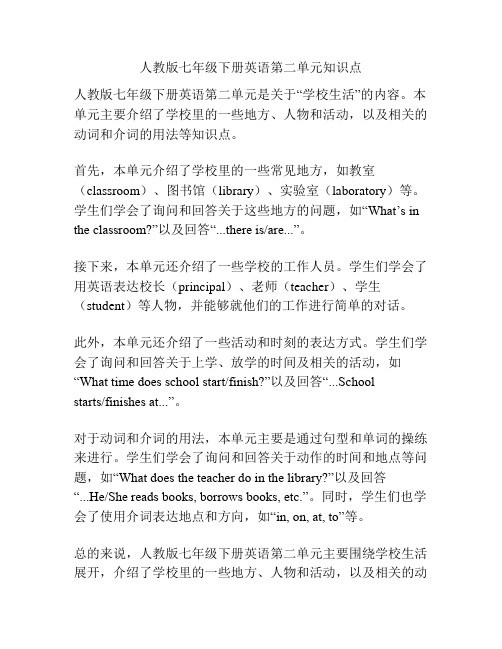
人教版七年级下册英语第二单元知识点人教版七年级下册英语第二单元是关于“学校生活”的内容。
本单元主要介绍了学校里的一些地方、人物和活动,以及相关的动词和介词的用法等知识点。
首先,本单元介绍了学校里的一些常见地方,如教室(classroom)、图书馆(library)、实验室(laboratory)等。
学生们学会了询问和回答关于这些地方的问题,如“What’s in the classroom?”以及回答“...there is/are...”。
接下来,本单元还介绍了一些学校的工作人员。
学生们学会了用英语表达校长(principal)、老师(teacher)、学生(student)等人物,并能够就他们的工作进行简单的对话。
此外,本单元还介绍了一些活动和时刻的表达方式。
学生们学会了询问和回答关于上学、放学的时间及相关的活动,如“What time does school start/finish?”以及回答“...Schoolstarts/finishes at...”。
对于动词和介词的用法,本单元主要是通过句型和单词的操练来进行。
学生们学会了询问和回答关于动作的时间和地点等问题,如“What does the teacher do in the library?”以及回答“...He/She reads books, borrows books, etc.”。
同时,学生们也学会了使用介词表达地点和方向,如“in, on, at, to”等。
总的来说,人教版七年级下册英语第二单元主要围绕学校生活展开,介绍了学校里的一些地方、人物和活动,以及相关的动词和介词的用法。
通过学习这些知识点,学生们可以更好地了解和应用英语,并能在日常生活中进行相关的交流和表达。
人教版七年级下册英语第二单元主要围绕学校生活展开,介绍了学校里的一些地方、人物和活动,以及相关的动词和介词的用法。
通过学习这些知识点,学生们可以更好地了解和应用英语,并能在日常生活中进行相关的交流和表达。
Unit2 SectionB (1a-1d)说课稿

Unit 2 This is my sister.Section B(1a-1d)说课稿一、说教材1.教材分析(本课在教材中的地位):本课是人教版英语七年级上册《Go for it》正式篇第二单元——This is my sister.本单元围绕介绍家庭成员开展听说读写教学活动,中心话题是“This is my sister”,学生的学习活动是在真实的生活场景中展开的。
并把“名词的单、复数形式”这一语法主线贯穿其中。
教学内容为语法的学习和使用提供了必要的感性材料,同时也体现了语法项目与交际情景自然结合的特点。
2.学情分析:学生为初一的新生,有一定的英语基础,且学习英语的兴趣较为浓厚。
英语基础较为扎实,课上能够积极地配合老师授课,课堂氛围活跃。
但是面对学习环境的闭塞,学生的课外英语知识积累较少,且学习的主动性欠缺,缺乏对新知识努力钻研的精神,学习方法欠佳。
3.教学目标a.知识目标:帮助学生掌握以下单词:grandfather,grandmother,grandparents,father,mother,parents,son,daughter,sister,brother, aunt,uncle,cousin,friend,these,those。
并对复数形式有初步了解。
b.能力目标:通过本节课学习,学生就家庭成员相互之间应该能用英语介绍、询问、交流。
并能用英语在脑子里对个家庭成员的关系进行思考。
例如,见到father’s mother,他们能反应出是指grandmother。
同时基本上能辨别什么时候用单数什么时候用复数。
c.情感目标:通过对家庭成员的学习,学生对自己的家庭成员会有更清晰的印象,从而激发起他们对家人的热爱。
4.教学重难点a.重点:熟练掌握各家庭成员的名称,会读会说会用这些词汇交流。
这个单元最主要的就是学习个家庭成员英语的表达,而几乎所有的单词都集中在第一课时。
所以这课时掌握这些单词应该是重中之中。
人教版七年级英语下册教学课件《Unit 2 Section A 2a-2d》

2b Listen again. Complete the shower schedule for Jim’s family.
Name Bob Mary Jack Jim Anna
7. Grace always exercises at six in the morning. (否定句) Grace ___n_e_v_e_r__ exercises at six in the morning.
➢ 中考链接
Tina gets up early every morning, so she
o’clock at night __t_o__ six o’clock in the morning.
Language points
1. job与work 辨析 job是可数名词,主要指有报酬的工作。 work是不可数名词,主要指要付出努力 的劳动。 鲍勃想找一份好的工作。 Bob wants to find a good __j_o_b__.
W__h_a_t_ _ti_m__e_d_o_e_s_ Jim eat breakfast? 5. Linda goes to work at seven thirty.
(划线部分提问) W ___h_e_n_ _d_o_e_s_ Linda go to work?
6. Eric doesn’t get up early on weekends. (同义句转换) Eric _g_e__ts_ _u_p_ l_a_t_e__ on weekends.
Time
6:00 6:10 6:20 6:30 6:40 7:00
人教版新目标英语七年级下-教材分析

《Go for it》七年级下册教材分析笔者对人教版新目标英语七年级下册教材进行了调查分析。
从学生用书,教师用书以及教学环境三个方面,采取个别访谈方法,就调查表格中的相关问题对3位初一英语教师以及班上4位学生进行了具体访谈。
同时,根据自己三个月的工作经验,对教材作出了分析评价。
以此,来了解该教材的优劣所在,并为自己今后的教学提供借鉴与指导。
首先调查的是学生用书,分为学习内容、词汇与语法、练习三个部分。
以下是调查结果:本教材以话题为主线,同时兼顾交际功能将教材分为了12个单元。
其后附有”tapescripts”, “pronunciation”, “grammar”, “words and expressions in each unit”以及”vocabulary index”五大板块。
对比以往简易的目录,此书每一单元不仅设有单元标题(title),还包含有话题(topic),功能(functions),结构(structures),目标语言(target language),词汇(vocabulary),复习(recycling)以及学习策略(learning strategies)等8个方面。
单单看目录,就能对整本书形成清晰的了解。
每个单元分为section A,section B,self-check三个板块。
每个版块按功能的不同,又分为1a-1c,2a-2c,3,4等。
Section A 以听说为主,而Section B以读写为主。
整本教材的内容贴近学生生活实际与学习兴趣,如问路,天气,周末活动,度假,时尚文化等。
并在听说版块深入非正式用语,及口语交际惯用表达,在教材后面的Tape-script版块,就有很多这样的表达。
在读写方面则通过招聘广告,给笔友写信等强调正式用语与书面语的表达规范。
让学生尽可能在听说读写中,地道地使用英语。
但,根据对正在使用教材的老师进行访谈后,发现还是存在一定的为学习英语而编造的学习内容。
七年级下册英语第2单元
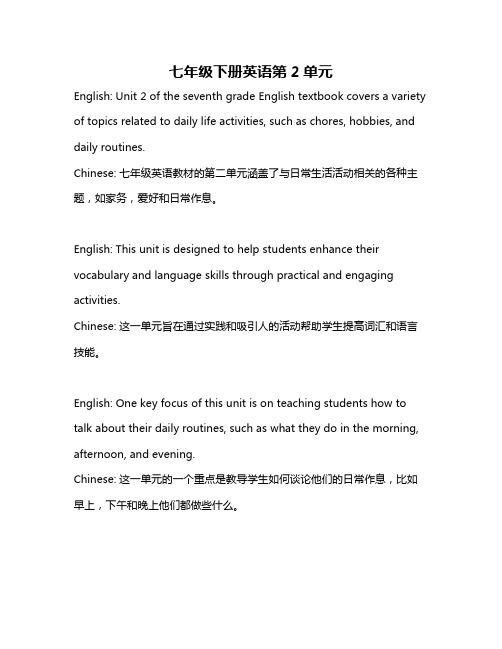
七年级下册英语第2单元English: Unit 2 of the seventh grade English textbook covers a variety of topics related to daily life activities, such as chores, hobbies, and daily routines.Chinese: 七年级英语教材的第二单元涵盖了与日常生活活动相关的各种主题,如家务,爱好和日常作息。
English: This unit is designed to help students enhance their vocabulary and language skills through practical and engaging activities.Chinese: 这一单元旨在通过实践和吸引人的活动帮助学生提高词汇和语言技能。
English: One key focus of this unit is on teaching students how to talk about their daily routines, such as what they do in the morning, afternoon, and evening.Chinese: 这一单元的一个重点是教导学生如何谈论他们的日常作息,比如早上,下午和晚上他们都做些什么。
English: By practicing dialogues and vocabulary related to daily activities, students can improve their communication skills in English and become more comfortable discussing their own routines. Chinese: 通过练习与日常活动相关的对话和词汇,学生可以改善他们的英语沟通技能,并更加自如地讨论他们自己的作息。
人教版高中英语选修7 Unit2_单元教材分析
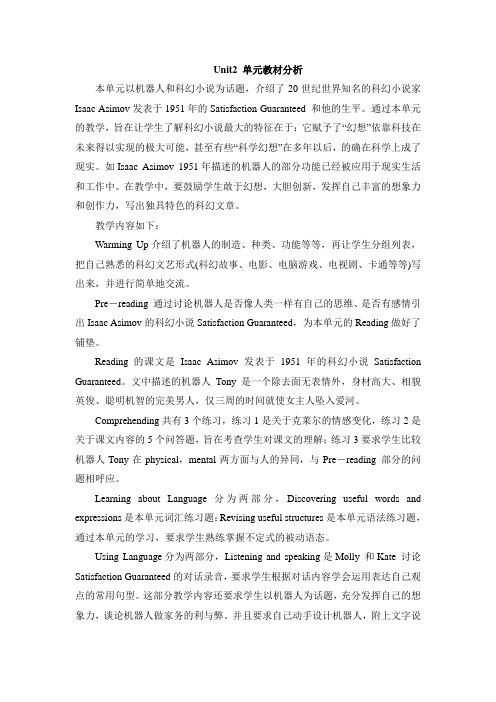
Unit2 单元教材分析本单元以机器人和科幻小说为话题,介绍了20世纪世界知名的科幻小说家Isaac Asimov发表于1951年的Satisfaction Guaranteed 和他的生平。
通过本单元的教学,旨在让学生了解科幻小说最大的特征在于:它赋予了“幻想”依靠科技在未来得以实现的极大可能,甚至有些“科学幻想”在多年以后,的确在科学上成了现实。
如Isaac Asimov 1951年描述的机器人的部分功能已经被应用于现实生活和工作中。
在教学中,要鼓励学生敢于幻想,大胆创新,发挥自己丰富的想象力和创作力,写出独具特色的科幻文章。
教学内容如下:Warming Up介绍了机器人的制造、种类、功能等等,再让学生分组列表,把自己熟悉的科幻文艺形式(科幻故事、电影、电脑游戏、电视剧、卡通等等)写出来,并进行简单地交流。
Pre-reading 通过讨论机器人是否像人类一样有自己的思维、是否有感情引出Isaac Asimov的科幻小说Satisfaction Guaranteed,为本单元的Reading做好了铺垫。
Reading的课文是Isaac Asimov发表于1951年的科幻小说Satisfaction Guaranteed。
文中描述的机器人Tony是一个除去面无表情外,身材高大、相貌英俊、聪明机智的完美男人,仅三周的时间就使女主人坠入爱河。
Comprehending共有3个练习,练习1是关于克莱尔的情感变化,练习2是关于课文内容的5个问答题,旨在考查学生对课文的理解;练习3要求学生比较机器人Tony在physical,mental两方面与人的异同,与Pre-reading 部分的问题相呼应。
Learning about Language分为两部分,Discovering useful words and expressions是本单元词汇练习题;Revising useful structures是本单元语法练习题,通过本单元的学习,要求学生熟练掌握不定式的被动语态。
七年级英语下册教学计划
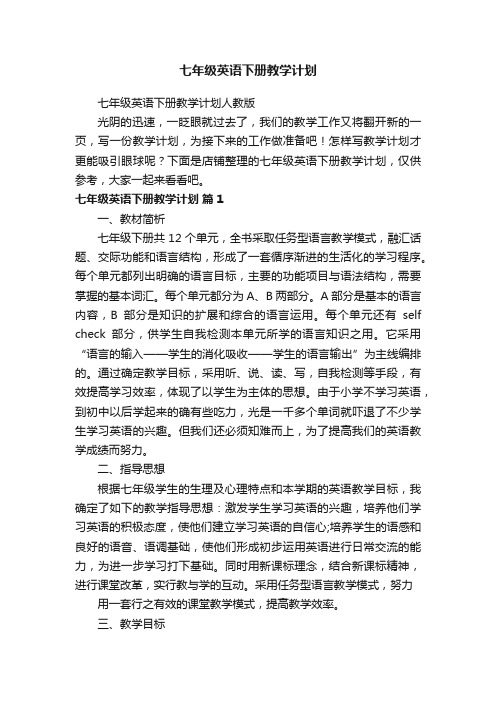
七年级英语下册教学计划七年级英语下册教学计划人教版光阴的迅速,一眨眼就过去了,我们的教学工作又将翻开新的一页,写一份教学计划,为接下来的工作做准备吧!怎样写教学计划才更能吸引眼球呢?下面是店铺整理的七年级英语下册教学计划,仅供参考,大家一起来看看吧。
七年级英语下册教学计划篇1一、教材简析七年级下册共12个单元,全书采取任务型语言教学模式,融汇话题、交际功能和语言结构,形成了一套循序渐进的生活化的学习程序。
每个单元都列出明确的语言目标,主要的功能项目与语法结构,需要掌握的基本词汇。
每个单元都分为A、B两部分。
A部分是基本的语言内容,B部分是知识的扩展和综合的语言运用。
每个单元还有self check部分,供学生自我检测本单元所学的语言知识之用。
它采用“语言的输入——学生的消化吸收——学生的语言输出”为主线编排的。
通过确定教学目标,采用听、说、读、写,自我检测等手段,有效提高学习效率,体现了以学生为主体的思想。
由于小学不学习英语,到初中以后学起来的确有些吃力,光是一千多个单词就吓退了不少学生学习英语的兴趣。
但我们还必须知难而上,为了提高我们的英语教学成绩而努力。
二、指导思想根据七年级学生的生理及心理特点和本学期的英语教学目标,我确定了如下的教学指导思想:激发学生学习英语的兴趣,培养他们学习英语的积极态度,使他们建立学习英语的自信心;培养学生的语感和良好的语音、语调基础,使他们形成初步运用英语进行日常交流的能力,为进一步学习打下基础。
同时用新课标理念,结合新课标精神,进行课堂改革,实行教与学的互动。
采用任务型语言教学模式,努力用一套行之有效的课堂教学模式,提高教学效率。
三、教学目标通过本学期教学,能基本达到如下目标:使对英语学习表现出积极性和初步的自信心,能听懂有关熟悉话题的语段和简短的故事,能与教师或同学就熟悉的话题(如学校、家庭生活)交换信息,能读懂小故事及其他文体的简单书面材料,能参照范例或借助图片写出简单的句子,能参与简单的角色扮演等活动,能尝试使用适当的学习方法,学会克服学习中的困难,意识到语言交际中存在文化差异。
- 1、下载文档前请自行甄别文档内容的完整性,平台不提供额外的编辑、内容补充、找答案等附加服务。
- 2、"仅部分预览"的文档,不可在线预览部分如存在完整性等问题,可反馈申请退款(可完整预览的文档不适用该条件!)。
- 3、如文档侵犯您的权益,请联系客服反馈,我们会尽快为您处理(人工客服工作时间:9:00-18:30)。
能意识到语言交际中存在文化差异。
教学目标
掌握本单元的重点词汇 及句型。学会询问和谈 论作息时间。掌握特殊 疑问句、表示频率副词 的用法。能根据自己的 学习实际制定合理的作 息计划。
通过活动,让学生主动参
与学习,合作探究学习,
提高听说读写与理解能力, 通过学习如何询问和 并学会描述自己及他人的 谈论作息习惯,培养
作息习惯。
学生的合作精神,养
成良好的作息习惯和
守时习惯。
重、难点
1.掌握本单元的重点词汇 及句型。 2.学会询问和谈论作息时 间。 3.掌握when和what time引 导的特殊疑问句。 4.掌握频率副词的用法。 5.能够根据自己的学习实 际制定合理的作息计划。
重、难点
1.学会询问和谈论作息时 间。 2.掌握when和what time引 导的特殊疑问句。 3.掌握频率副词的用法。
人教版义务教育教科书七年级英语下册
Unit 2 What time do you go to
school?
教材分析
(1) 教材的地位和作用
本单元以“日常活动”为话题,围绕 “What time do you do … ?” 一般现在时特殊 疑问句的功能项目开展教学活动。本单元是七 年级英语重要语法项目之一,通过讨论学生的 日常活动,进行一般现在时的特殊疑问句的训 练,同时通过本话题,进一步提高学生的听、 说、读、写的综合能力的培养。
(2) 教材的应用
在教材的处理过程中,根据教学的重点和难 点与教学流程的需要和学生的特点,对教材进行 了重组与编排,灵活地将生词、短语、句式和语 法穿插在整个教学环节。
在信息采集上,在网上收集与教学相关的图 片,将本课的重点短语与图片结合。教学课件的 使用,体现了多媒体技术在英语学科的应用,有 效地利用了远程教育网上的共享资源,让学生在 轻柔、愉悦的氛围下快乐地学习英语。
课时分配
第一课时:SectionA 1a-2d (听说课) 第二课时:SectionA G/F-3c(语法课) 第三课时:SectionB 1a-1e (听说课) 第四课时:SectionB 2a-2c (阅读课) 第五课时:SectionB 3a-3b (写作课)
教学方法
情境交 际法
任务型 教学法
学情分析
学情分析
在七上第八单元, 学生们已经学习了 when引导的特殊 疑问句,并且能做 简单的问答。
学生已有初步的 听、说、读、写 能力,但对课题 知识归纳总结的 能力有待提高。
课标要求
对英语学习表现出积极性和初步的自信心。
能听懂有关熟悉话题的语段和简短的故事。能与教师 或同学就熟悉的话题(如学校、家庭生活)交换信息。 能读懂小故事及其他文体的简单书面材料。能用短语 或句子描述系列图片,编写简单的故事。能根据提示 简要描述一件事情,参与简单的角色表演等活动。
多媒体 展示法
小组合作 探究法
单元导入,明确目标 学习新词,及时巩固 听力练习,感知课文 对话练习,拓展延伸 达标测试,课堂小结
听说课
单元导入,明确目标 初读课文,学习生词 再读课文,整体感知 细读课文,分析鉴赏 变式训练,巩固提高 达标测试,课堂小结
立体导入,明确目标 讲解新知,分析规律 巩固练习,互查互助 达标测试,当堂巩固 课堂小结,单元回归
情景导入,明确目标 知识梳理,建构体系 文章写作,自查修改 同伴合作,批改提升 课堂小结,评价反思 布置作业,巩固提高活动设计ຫໍສະໝຸດ 小组 讨论角色 扮演
猜词 游戏
头脑 风暴
作业设计
掌握目标语言 在实际生活中运用知识
目 标 解决现实问题
评价
时间
内容
课后作业 拓展性作业 前置性作业
类型
听力、口头、 书面
